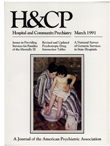Dissociative Experiences in the General Population: A Factor Analysis
Abstract
The 28-item Dissociative Experiences Scale was administered to a stratified cluster sample of 1,055 respondents in the general population of Winnipeg. Dissociative experiences were common in the sample and were not related to socioeconomic status, sex, education, religion, or place of birth, although they declined with age in both sexes. A principal components analysis identified three factors accounting for 47.1 percent of the combined variance of the scores. The first factor, absorption-imaginative involvement, is composed of common, benign experiences, such as missing part of a conversation and being able to ignore pain. The other two factors, activities of dissociated states and depersonalization-derealization, composed of less common experiences such as not recognizing friends or family members and not recognizing one's reflection in a mirror, may be powerful predictors of DSM-III-R dissociative disorders.
Access content
To read the fulltext, please use one of the options below to sign in or purchase access.- Personal login
- Institutional Login
- Sign in via OpenAthens
- Register for access
-
Please login/register if you wish to pair your device and check access availability.
Not a subscriber?
PsychiatryOnline subscription options offer access to the DSM-5 library, books, journals, CME, and patient resources. This all-in-one virtual library provides psychiatrists and mental health professionals with key resources for diagnosis, treatment, research, and professional development.
Need more help? PsychiatryOnline Customer Service may be reached by emailing [email protected] or by calling 800-368-5777 (in the U.S.) or 703-907-7322 (outside the U.S.).



